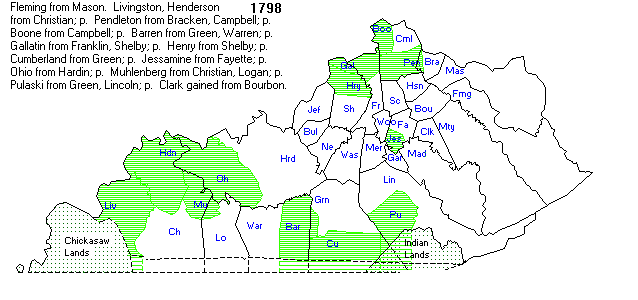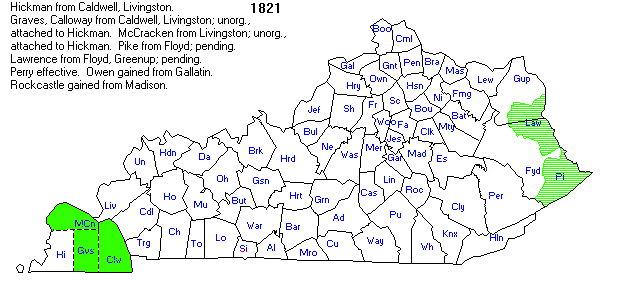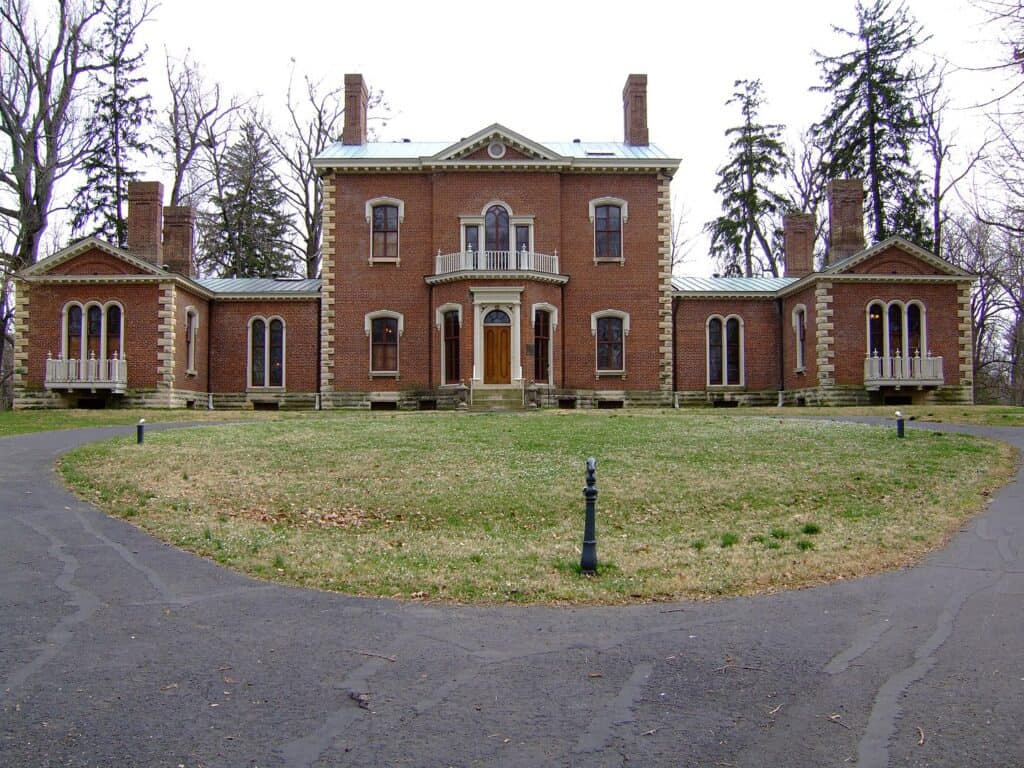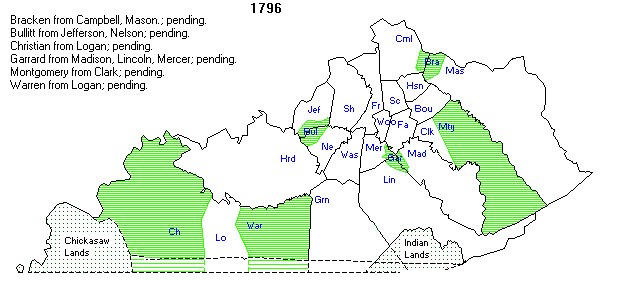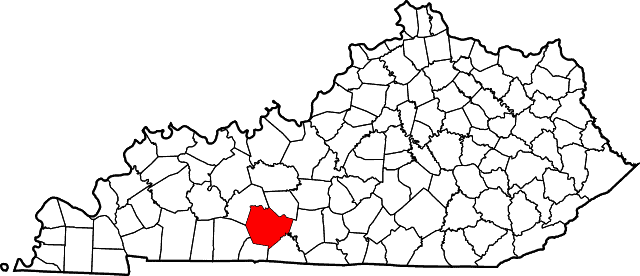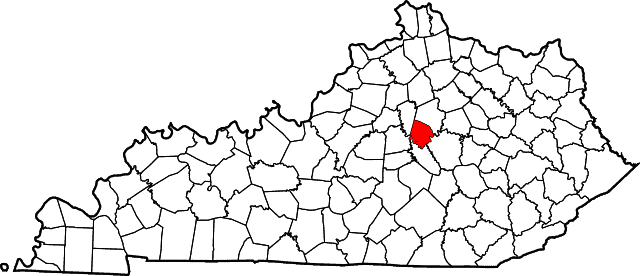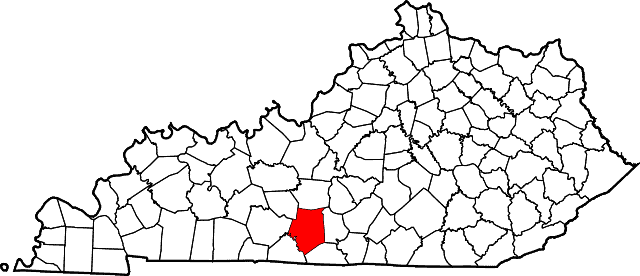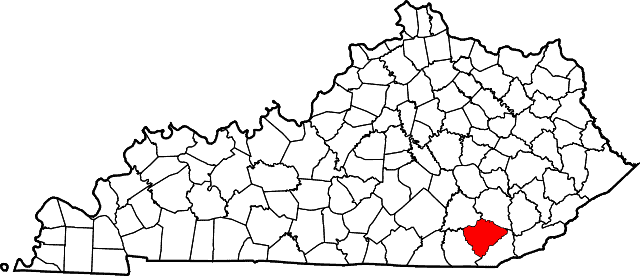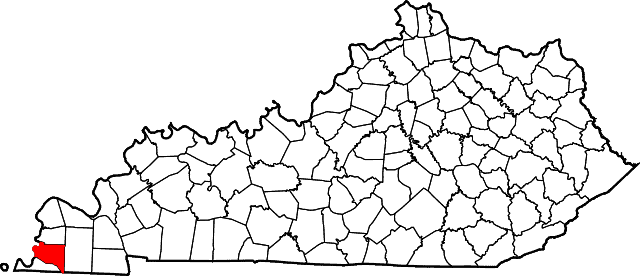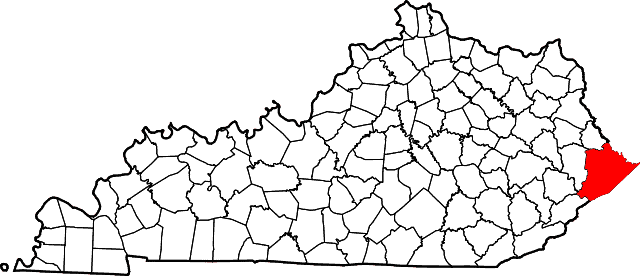Kentucky Trivia
December 19, 1796, Kentucky created Warren County from Logan County and named it in honor of Joseph Warren, Revolutionary War General. Bowling Green is the county seat. Other localities include Oakland, Plum Springs, Smiths Grove, Woodburn, Plano, Anna, Bristow, Girkin, Glenmore, Gotts, Hydro, Kepler, Loving, Martinsville, Polkville, Pondsville, Richardsville, Riverside, Sunnyside, Three Forks, and Tuckertown. In South Warren localities include Alvatonm Blue Level, Boyce, Browning, Claypool, Drake, Greenhill, Guy, Hadley, Hardcastle, Lost River, Matlock, Memphis Junction, Petros, Rich Pond, Rockfield, Rockland, Shawnee Estates, Springhill, and Three Springs. The 23rd county created covers 546 square miles.
Warren County By David Benbennick December 19, 1798, Kentucky created two counties.
Kentucky Counties 1798 December 19, 1798, Kentucky created Jessamine County from Fayette County and named it for the Jessamine Creek, which contains a set of rapids that are the county’s most well-known natural feature. Nicholasville is the county seat. Other cities and towns include Wilmore, High Bridge, Brannon Woods, and Keene. The 27th county created covers 175 square miles.
Jessamine County By David Benbennick December 19, 1798, Kentucky created Barren County from Warren and Green counties and named it for the “barrens,” or meadowlands covering the northern third of the county. Glasgow is the County seat. Other localities include Austin, Cave City, Eighty Eight, Hisevile, Lucas, Park City, Pritchardsville, and Temple Hill. The 29th county formed covers 500 square miles.
Barren County By David Benbennick December 19, 1799, Kentucky created Knox County from Lincoln County and named it in honor of Henry Knox, the 1st U.S. Secretary of War. Barbourville is the county seat. Other localities include Corbin, (primarily in Whitley County) Artemus, Flat Lick, North Corbin, (primarily in Laurel County) Gray, and Kay Jay. The 42nd county created covers 388 square miles.
Knox County By David Benbennick Kentucky 1821 Map December 19, 1821, Kentucky created Hickman County from Caldwell County and Livingston County. We named the county in honor of Paschal Hickman, a military captain killed at the Battle of Frenchtown. Clinton is the county seat. Columbus is another community. The 69th county created covers 253 square miles.
Hickman County By David Benbennick December 19, 1821, Kentucky created Pike County from Floyd County and named it in honor of Zebulon Pike, western explorer and discoverer of Pike’s Peak. Pikeville is the county seat. Other cities and towns located in the county include Coal Run Village, Elkhorn City, Belfry, Freeburn, McCarr, Phelps, South Williamson, Ashcamp, Beefhide (partial), Belcher, Broad Bottom, Canada, Cedarville, Dorton, Fedscreek, Fords Branch, Garden Village, Hellier, Jonancy, Kimper, Lick Creek, Mouthcard, Phyllis, Raccoon, Shelbiana, Sidney, Stone, Stopover, Varney, and Virgie. The 71st county created, Pike County, covers 789 square miles, making it Kentucky’s largest county.
Pike County By David Benbennick December 19, 1891, Kentucky State College (UK) played their only football game of the season and lost to Centre, their 1st time playing each other. Kentucky donned blue and light yellow after a student asked, “What color blue?” and varsity letterman Richard C. Stoll pulled off his necktie and held it up, originating Kentucky blue. The following year, the college dropped light yellow and changed it to white.
December 19, 1920, the government sounded the alarm on the decreasing horse population . With the automobile’s mass production, horses declined in usefulness in towns, cities, and farms. The Secretary of the Horse Association stated extensive and responsible breeding would be the only remedy.
December 19, 1950, Army PVT Bobby Davis from Christian County died in the Korean War.
December 19, 1959, Governor Bert T. Combs called for a Special Session in one of his 1st acts as governor. He wanted a new Kentucky constitution, got one passed, and gave it to the people to vote on in November of 1960. Kentuckians defeated it by almost 18,000 votes, making it the closest we came to replace the 1891 constitution, which remains in effect today.
Analogue Kid From early morning, December 19, 1964, freezing rain, sleet, and snow brought hazardous driving conditions to Western Kentucky . Police confirmed over 100 accidents in McCracken County and 100 in Graves County before dark.
December 19, 1970, Lee Corso’s Louisville Cardinals tied Long Beach State in the Pasadena Bowl at 24 to end the season 8-3-1.
December 19, 1974, Nelson Aldrich Rockefeller became the 41st U.S. Vice President after President G. Ford nominated him and Congress confirmed him.
December 19, 1980, the failure to find adequate financing forced the Louisville International Tennis Classic to cancel the 1981 tennis tournament, thus ending professional tennis in Kentucky.
December 19, 1984, a state strip-mine inspector told the press he had been under house arrest for nearly two months while his superiors investigated allegations that were not made public.
On December 19, 1990, General Calvin Walker told President G.W. Bush that the military was not ready to attack Iraq on January 15 as requested . Months earlier, a 15-year-old Iraqi girl told the U.S. Senate she witnessed Iraqi soldiers take babies out of incubators in a Kuwaiti hospital to let them die. President George H. W. Bush repeated the false testimony numerous times to rationalize the Gulf War.
December 19, 1994, Medicaid wanted back $831,703 from three Kentucky dentists for incorrect invoices dating back to 1986.
December 19, 2006, Trooper Jonathan Kyle Leonard, Kentucky State Police , died in an automobile accident on US 119 in Pike County while responding to a domestic violence call.
December 19, 2008, days before President W. Bush left office, he bailed out his donors as the world economy crashed . The president gave $17.4 billion to GM and Chrysler. Even corporate Mitch claimed foul and publicly admonished the socialist program called Troubled Assets Relief Program (TARP) that handed out $700 billion. Meanwhile, Kentuckians saw a jump in foreclosures across the state as shrinking endowments “walloped” state colleges.
December 19, 2015, the National Cancer Institute’s study claimed Kentucky was #1 in cancer deaths in the U.S per capita . Lung cancer claimed the #1 culprit in Kentucky and ranked in the top 10 nationally for breast, colorectal, and cervical cancers. Lung cancer statistics were staggering: 92.4 incidences per 100,000 people compared with 60.4 nationally.
December 19, 2018, the Kentucky General Assembly ignored the pleas of Governor M. Bevin and ended the surprise special session he called the day before to address the ailing public pension crisis. Lawmakers based their decision on the fact that the pension disaster evolved over many years, and a five-day special session would not solve it.
December 19, 2020, Congress worked on the final details of spending $2,300,000,000,000. The bill included $900 billion for the coronavirus and a $1.4 trillion omnibus bill. Two days later, Nancy Pelosi released the 5,593-page bill and gave members hours to read to read it before they voted. The Senate Historical Office claimed it was the longest bill in congressional history.
